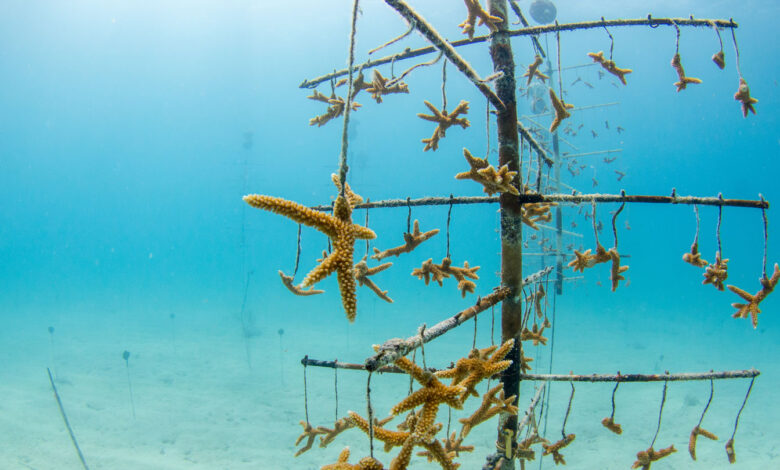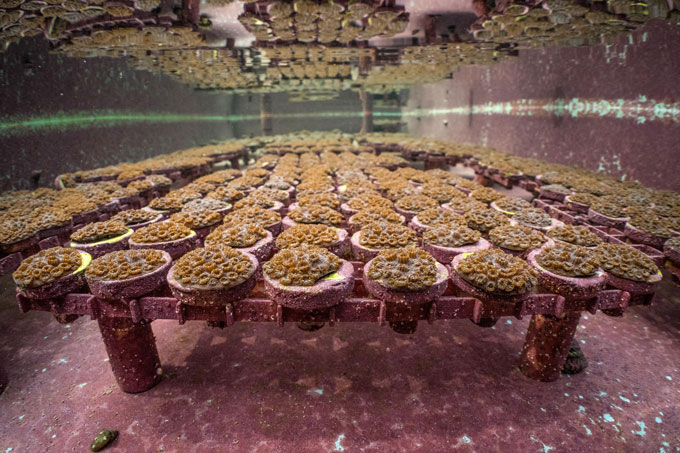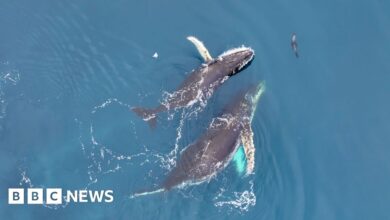Fake fog, ‘re-skinning’ and ‘sea-weeding’ could help coral reefs survive

Erinn Muller should have reason to despair. The marine biologist studies coral health in Florida, a state whose reefs have been devastated by extreme heat, increasingly ferocious hurricanes and deadly infectious diseases (SN: 6/15/23; SN: 9/13/23; SN: 7/9/19).
“We’ve lost 98 percent of our living coral cover,” says Muller, of the Mote Marine Laboratory in Sarasota, Fla. While among the hardest hit, Florida isn’t alone. From Australia’s Great Barrier Reef to the Caribbean, coral reefs globally are in trouble.
But innovative efforts to protect and restore coral reefs buoy Muller’s hopes. She just has to visit Mote’s Caribbean king crab nursery, a project of reef restoration expert Jason Spadaro. There, tiny specks of crustaceans will grow into salad-loving foragers. Once they are set loose on nearby reefs, Maguimithrax spinosissimus eat away suffocating seaweed.
“I’m optimistic because there is really truly so much work being done” to restore coral reefs, says Tali Vardi, a marine biologist and executive director of the Coral Restoration Consortium, a global community of scientists, managers and restoration experts dedicated to helping coral reefs. While safeguarding the future of coral reefs ultimately depends on halting climate change, “we’re trying to maintain pockets of biodiversity” that can serve as a springboard for the long-term recovery of reefs.
Given how diverse coral reefs are, Vardi says, researchers need a diversity of solutions to match. “There’s no silver bullet here.”
Around the globe, coral biologists are trying everything from low-tech seaweed removal to high-tech artificial fog production to protect corals. Here’s a closer look at three projects that researchers are developing to help save coral reefs.
Sea-weeding, literally
In Australia’s Great Barrier Reef, it’s not crabs doing the weeding. It’s volunteers with Earthwatch Institute — an international environmental organization — snorkeling and diving underwater to pluck macroalgae, the weed of the sea. The volunteers’ goal is to free parts of the reef from a seaweed scourge to see if that leads to a resurgence in coral.
“There’s been this issue with increases in macroalgae versus corals for a long time,” says David Bourne. “If something’s out of whack” with the reef ecosystem, “the corals lose out and the macroalgae take over.”
Though they seem like a cross between plants and rocks, the hard corals that form reefs are actually giant colonies of tiny animals called coral polyps. The polyps secrete a hard skeleton made of calcium carbonate, and skeleton by skeleton, they build an undersea city. Tiny photosynthetic algae partners living inside the polyps give the corals their brilliant colors and generate energy for their hosts.
Seaweed, however, takes up space and soaks up light that could otherwise be used by corals. If corals decline in number due to stressors like heat or disease, seaweed can quickly proliferate and take their place.
Bourne, a marine biologist at James Cook University in Townsville, Australia, wanted to know if the seaweed-removal program being run by Earthwatch was effective. From 2018 to 2021, volunteers pruned seaweed from 24 sections of the reef — each 5 meters by 5 meters — several times per year, while leaving other seaweed-laden areas alone. In total, they removed a whopping 2,148 kilograms of seaweed.
At the start, the tended plots had enough corals to cover only about 34 square meters. Removing macroalgae from those plots led to a total gain of nearly 203 square meters of coral cover, enough to blanket a tennis court, Bourne’s team reported September 13 in the Journal of Applied Ecology. This change wasn’t seen in the plots left unpruned.
“It’s not surprising that we saw some recovery,” Bourne says. “What was surprising was the amount of recovery and how quickly it happened.” Sea-weeding is a straightforward way to skew the reef’s competitive balance and help corals thrive, he says.
Bourne hopes the simplicity of the approach will help it spread. “The advantage of sea-weeding is it’s really low tech; anybody can do it,” he says. Plus, seaweed tends to be an issue on reefs that are close to shore and known to local communities, “so there’s active groups that are interested in helping.”
‘Re-skinning’ a coral skeleton
Though it may sound macabre, the calcium carbonate skeletons of dead reefs can serve as vital scaffolding for new corals to flourish. “Re-skinning” a dead reef takes advantage of coral microfragments, small bits of coral polyps. Growing microfragments in the lab and then transplanting them onto reef skeletons can, in a way, bring a dead ecosystem back to life.
David Vaughan discovered the restorative potential of coral microfragments through what he calls a “eureka mistake.” Vaughan, formerly executive director of Mote and now head of the nonprofit Plant A Million Corals in Summerland Key, Fla., accidentally broke off shards of a branching coral while moving it to a new tank. Some coral polyps remained on the bottom of the tank. Vaughan assumed the tiny animals wouldn’t survive. But when he checked on them about two weeks later, he saw instead that they had quickly grown and multiplied.
Large corals grow slowly, Muller says, because they have to put a lot of energy into creating more of their calcium carbonate skeleton. If you instead affix multiple microfragments, consisting of a thin skeletal layer with a small bit of live coral tissue on top, near each other on a hard surface, they grow rapidly and fuse together. Mote scientists “hacked the biology of a lot of these slow-growing species to encourage them to put a lot of their resources into creating tissue faster,” Muller says.

A 2018 study found that microfragments of the mountainous star coral (Orbicella faveolata) grew 10 times as much tissue over a 31-month period as the normal, larger fragments that were previously used for reef restoration. For every square centimeter of coral that was planted at the beginning of the experiment, microfragments grew an average of 3.38 square centimeters of new tissue, while larger fragments grew only 0.35 square centimeters. Ocean plantings of coral microfragments have since withstood disease, bleaching and hurricanes, and grown large enough to reproduce within several years.
“Spawning after five years,” Spadaro says, “was definitely a game changer in terms of restoration.” Re-skinning with microfragments can give you functional reef ecosystems in a fraction of the time as previous methods. Mote scientists have since shared their knowledge with others working to restore corals around the world, such as in Hawaii and the Caribbean.
Making shade
Bleaching is the dramatic outcome of great hardship; pushed to the brink by extreme stress, a strained coral belches out its symbiotic photosynthetic algae, turning stark white and losing its primary food source. Excessive heat is the most common culprit, but it’s not the only one.
Excess light can lead to bleaching, too, says Peter Butcherine, a biologist at Southern Cross University in Coffs Harbour, Australia. Too much light during photosynthesis, performed by the corals’ algae partners, leads to an abundance of toxic oxygen-containing molecules that are highly reactive and can cause cell death. Protecting corals from too much sun exposure can help prevent bleaching, but “you can’t roll out thousands of square meters of shade cloth” to shield an area the size of the Great Barrier Reef, Butcherine says.
Instead, Butcherine and others have turned to a more ephemeral approach: creating fog. “It’s essentially a sea mist,” Butcherine says. Though misting the entire Great Barrier Reef isn’t feasible, marine fog could be used to protect sensitive parts of the reef during the time of day when sunlight is at its harshest.
Butcherine and colleagues showed that shading corals for just four hours a day can delay bleaching even when water temperatures are high, such that corals could withstand three extra weeks of bleaching-level heat. The results of that laboratory study were published in the Sept. 20 Frontiers in Marine Science. This delay could help corals hold on to their algal partners until the environment around them cools.
Because it’s still being developed, marine fogging is quite expensive; it requires large arrays of misters mounted to ships. But Butcherine is excited by the potential of using solar power, including sun-powered drones mounted with misters, to implement the technique at a wider scale, and even at other reefs around the world.
“I’m optimistic that we can make a difference,” Butcherine says.
Source



